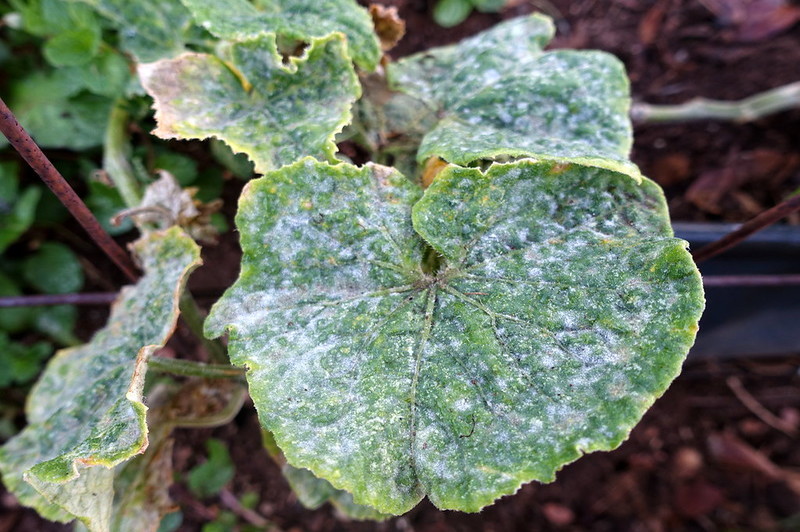If you are wondering how to identify powdery mildew, this guide can help you. Learn about how powdery mildew looks like, how you can treat it, and how to prevent it.

What Is Powdery Mildew?
Powdery mildew is a specific type of fungal disease that infects a wide variety of plants. There are many species of this type of mildew, of which each species attacks a specific range of plants.
Usually, powdery mildew affects plants, including nightshades (peppers, tomatoes, eggplants), legumes (peas, beans), cucurbits (melons, cucumbers, pumpkins, squash), and roses.
Once the fungus begins to infect a plant, it will create a layer of spores over the leaves. These spores will then be spread to the other plants through the wind, thus infecting them.
When infected by powdery mildew, plants may grow slowly and have reduced quality and yield if the infection is severe.
Identifying powdery mildew
Powdery mildew is not hard to spot and identify. It can be seen both in indoor and outdoor gardens.
If you notice white powdery build-up on the leaves of your plants, chances are it is powdery mildew. This fungus appears as small patches on some parts of the leaves in the beginning.
It will spread to other areas until it covers the entire leaf as time goes by. It happens if the powdery mildew is not dealt with immediately will cause damage that’s beyond repair.
It would be best if you will also take note that powdery mildew may not be entirely visible at all times. It may also appear less obvious as it lightly covers the surface of the leaf.
Powdery mildew loves cool, humid, stale conditions. They are usually found in areas with no direct sunlight, so you might want to check on your plants often.
How to treat powdery mildew
When you happen to spot plants that are infected by powdery mildew in your home or garden, immediately move them away from unaffected plants to avoid the infection from spreading.
Afterward, deal with the damaged plants elsewhere. Trim the affected leaves, buds, and stems.
If the entire plant has been affected, you can compost it to confine the fungus if possible. For controlling and eliminating powdery mildew, you can use any of these options as a spray:
1. Milk spray
It may sound weird and a little gross, but milk is a really effective agent to control powdery mildew. All you need to do is create a mixture of two parts of milk with three parts of water and transfer it into a spray bottle.
Although it can be stinky, especially indoors, it is really effective. Researchers were yet to explain why it works but have confirmed that milk really does work!
2. Baking soda spray
Baking soda has been proven one of the most useful remedies to various home problems. It has a high pH which powdery mildew fails to tolerate.
To make the spray, just mix a few drops of dish soap, 1 quart of water, and one teaspoon of baking soda.
3. Neem oil spray
Neem oil has the ability to disrupt the spore production of the fungus. It controls and eventually eliminates the powdery mildew.
To create the neem spray, mix 1 quart of water, a few drops of a mild dish, and one teaspoon of neem oil. Pour it in a spray bottle and spray it on the affected plants.
You have to remember that some plants may be sensitive to neem oil, so you should perform a test spray on a small part of the plant before you apply the solution to the entire plant.
4. Copper fungicide
If you are not a fan of making DIY sprays and prefer buying something instead, you can go for copper fungicide. It has the ability to control several fungal diseases, including powdery mildew.
You just need to follow the instructions stated on the back of the product for proper use. It is typically available in 0.5 and 2 ounces per gallon.
If you are thinking of using potassium bicarbonate, here is an article to help you know where to buy potassium carbonate for powdery mildew that you can check out.
If dealing with zinnias, here is a specific guide on how to treat powdery mildew on zinnias that you can read.
Prevention
There are a few preventive measures you can take to avoid powdery mildew. Here are some of them:
- When deciding on plants, choose the ones that are resistant to powdery mildew. There are varieties of cucurbits (squash, cucumbers, melons) that are developed to be mildew-resistant.
- As much as possible, plant in areas with direct sunlight as mildew often tends to develop in shady areas.
- Prune crowded areas to increase airflow around your plants to help in reducing relative humidity.
Conclusion
Plants, just like humans, can also be affected by diseases like powdery mildew. It is why it is essential for gardeners and plant owners to know how to identify powdery mildew, to control it as immediately as possible, and avoid any severe damage.
